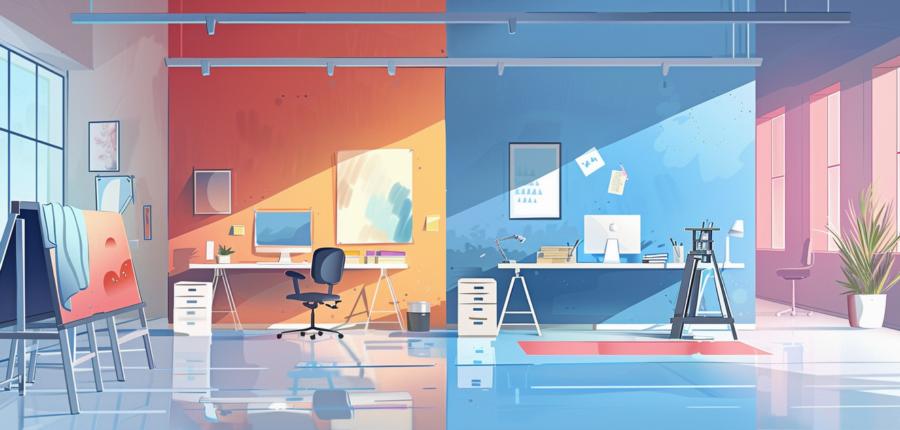Timing isn’t everything. It’s the only thing—unless you want to explain to your finance team why they’re suddenly working from the stairwell.
Choose the Right Time or Prepare for Chaos
There’s no universally perfect time to repaint an office, but there are several spectacularly bad ones. Month-end reporting week? Disaster. The week your CEO is in town for walkthroughs? Bold, but foolish. Ideally, you’ll aim for a weekend or public holiday window, or—if your team runs on hybrid schedules—target the days your space is already running lean.If repainting in a single weekend feels like trying to land a commercial jet in a supermarket car park, you’re not wrong. For larger spaces, a phased approach can work wonders. Tackle the project zone-by-zone, shifting staff accordingly. Just make sure the team actually knows where to go (ideally before they’re standing in front of a freshly-rolled “Do Not Enter” sign).
Minimizing the Mess
Paint isn’t inherently chaotic. People interacting with paint? Now we’re cooking with volatility.You’ll need to plan for:
- Noise: Rolling and prepping isn’t silent. If your team needs quiet zones for calls or focused work, get those scheduled outside of active painting hours or shifted to alternate rooms temporarily.
- Odour: Even low-VOC paints have a scent. Ventilation is your friend. Box fans, open windows (if you have them), and temporary relocations can help you avoid fogging the whole team into submission.
- Furniture: Moving desks and gear is a job best done by professionals or well-fed volunteers. Either way, label cables, mark desk arrangements, and take a few photos beforehand so you can put Humpty back together again.
Tell People. Then Tell Them Again.
Most office horror stories start with something that “was in an email.” Paint plans are no exception.Start with a simple, centralized timeline: who’s painting what, when, and how it affects access. Then repeat that message at least three different ways—email, Slack, and, ideally, something that people physically see (signage, whiteboards, polite notes taped over coffee machines).
Communicate what’s expected of employees:
- Will they need to clear desks?
- Should plants go home for the week?
- Do they have a temporary desk or are they working remotely?
Set Expectations Without Sparking Revolt
Once people know paint is coming, you’ll want to walk the thin line between transparency and panic. This is not the time for corporate spin like “experiencing a vibrant transformation initiative.” Be direct. It’s paint. It might smell. You might have to work in the break room for a day. You will survive.Set expectations around what success looks like. For example:
- “Yes, the colour will look different when it dries.”
- “No, the team isn’t getting standing desks just because we had to move your chair.”
- “That one weird wall patch is being fixed Tuesday. Calm yourself.”
Test the Paint Before It Tests You
Every office has one person who will emotionally unravel over the wrong shade of white. Don’t let that person derail your post-paint peace.Before the full job begins, test a sample or two in real light—both natural and overhead. Office lighting is notorious for turning “soft linen” into “smoker’s lung.” Testing under different lighting conditions can save you from repainting a week later because it “looked different on the swatch.”
Better yet, involve a few key stakeholders early (not the entire team—this isn’t democracy, it’s wall prep). When people feel like they’ve had a say—even a tiny, rigged one—they’re less likely to rebel.
Reassembly and Recovery
Once the last coat is dry and you’ve given it adequate time to off-gas, it’s time to put the office back together. This part always takes longer than expected and usually involves at least one piece of tech that no longer works for unknown reasons.Work in reverse from your prep list. Use your “before” photos to place desks and fixtures. If anything’s changed—painted over outlets, hard-to-reach switches—label them now, before someone logs a facilities ticket titled “The Printer Is Possessed.”
Also, resist the urge to rush everyone back in. Even low-odour paint needs ventilation time. Give it 24 hours if you can, and keep windows cracked open or fans running. You’ve come this far without a rebellion—don’t blow it by choking everyone out on Monday morning.
Brush Up and Move On
Repainting your office doesn’t have to be a productivity massacre. With a solid plan, clear communication, and a pinch of flexibility, you can refresh your space without giving half your staff an existential crisis.You might even find morale ticks up—not just from the cleaner space, but from the fact that leadership handled a messy task with… well, some grace. And duct tape. Possibly a megaphone.
Just don’t let Dave from accounting choose the colours next time.
Article kindly provided by mountgravattpaintingpros.com.au

